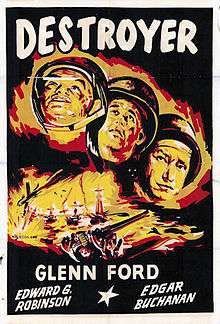Destroyer (1943 film)
| Destroyer | |
|---|---|
 Theatrical Film Poster | |
| Directed by | William A. Seiter |
| Produced by | Louis F. Edelman |
| Written by | Frank Wead |
| Screenplay by |
Borden Chase Lewis Meltzer |
| Starring |
Edward G. Robinson Glenn Ford Marguerite Chapman Edgar Buchanan |
| Music by | Anthony Collins |
| Cinematography | Franz Planer |
| Edited by | Gene Havlick |
| Distributed by | Columbia Pictures |
Release dates |
|
Running time | 99 minutes |
| Country | United States |
| Language | English |
| Box office | $1.3 million (US rentals)[1] |
Destroyer is a 1943 Columbia Pictures war film starring Edward G. Robinson and Glenn Ford as U. S. Navy sailors in World War II.
Lt. Comm. Donald Smith, the film's technical advisor, served as Navigation Officer on the USS Arizona (BB-39) until one month before the ship was sunk at Pearl Harbor.[2]
Plot
In 1943 retired Navy Chief Bosun's Mate Steve "Boley" Boleslavski (Edward G. Robinson) helps build the destroyer John Paul Jones, the namesake of the ship he served on in World War I, sunk a quarter century later while saving an aircraft carrier from being torpedoed. When he finds out that an old shipmate, Lieutenant Commander Clark (Regis Toomey), is the ship's new captain, he returns to the Navy and wrangles a berth as the ship's leading chief bosun's mate.
However, Boley soon alienates the rest of the destroyer's crew with his perfectionist attitude and ignorance of the ship's modern equipment, particularly Mickey Donohue (Glenn Ford), whom he replaced as leading chief. As a result, the ship's crew and equipment perform poorly on the Jones's shakedown cruise. Boley is demoted for striking Donohue when the latter goads him by insulting the Jones. Donahue becomes leading chief again. To further complicate matters, Donohue falls in love and secretly marries Boley's daughter Mary (Marguerite Chapman).
Mary talks Donahue into letting Boley remain aboard the Jones, and he is injured rescuing crewmen during a fire. Boley will recover but is barred from further sea duty and sent to collect his gear. Because of its poor showing, the Jones has been assigned to carry mail to Dutch Harbor, Alaska, and its disgruntled crewmen applied for transfers to fighting ships. Boley returns just as they are packing their gear and talks them out of transferring with a stirring account of John Paul Jones' epic Revolutionary War battle with the HMS Serapis.
A Japanese fleet is spotted trying to bring reinforcements to their garrison on Kiska Island, and the crew of the Jones eagerly answers the general order to converge on the enemy. Higher headquarters contemptuously changes their orders and sends them to the safe port of Sitka. En route, the Jones is attacked by six enemy airplanes, shooting down all of them but is struck by a torpedo during the fight. When a hostile submarine is detected, the crippled ship has to flee at its best speed. It manages to evade attack until night falls, but the list of the ship extinguishes its boilers, stopping the engines. The captain has no choice but to give the order to abandon ship. Boley is given a chance to stay aboard with a few volunteers, including Donohue, to try to weld shut the hole. He succeeds just before dawn, when the submarine attacks. The destroyer drops depth charges, forcing the submarine to the surface, then rams and sinks it.
When the ship docks to much fanfare, Boley willingly returns "to the beach" after the crew expresses its reluctance to see him go. There he learns that Donohue has married his daughter, to which he feigns dismay.
Cast
- Edward G. Robinson as Steve Boleslavski
- Glenn Ford as Mickey Donohue
- Marguerite Chapman as Mary Boleslavski
- Edgar Buchanan as Kansas Jackson
- Leo Gorcey as Sarecky
- Regis Toomey as Lieutenant Commander Clark
- Edward Brophy as Casey
- Warren Ashe as Lieutenant Morton
- Benson Fong as Japanese sonar man (uncredited)
- Richard Loo as Japanese submarine captain (uncredited)
- Lloyd Bridges as Second Fireman (uncredited)
- Larry Parks as Ensign (uncredited)
References
External links
| Wikimedia Commons has media related to Destroyer (1943 film). |
- Destroyer at the TCM Movie Database
- Destroyer at the Internet Movie Database
- Destroyer at AllMovie
- Destroyer at the American Film Institute Catalog